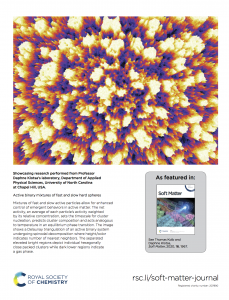Klotsa group publishes “paper of the month” in Soft Matter

 Klotsa group’s recent article is picked paper of the month by the Soft matter blog and gets showcased in the backcover by the journal. “From schools of sardines to flocks of starlings, the complex, collective behavior found in natural swarms has spurred an interest in active-matter systems, where constituents locally convert energy into motion. In this paper, a new direction in the burgeoning field of active matter is explored” explains assistant professor Daphne Klotsa. “While a plethora of studies have shown remarkable findings in active matter, the effect of mixtures of particles with distinct active driving forces remains surprisingly largely unexplored” says Chemistry graduate student Tom Kolb and lead author of the study. “In nature we encounter a wealth of multicomponent active systems ranging in scale from the microscopic (e.g. mixtures of bacteria with different motility mechanisms or speeds and microorganism swarms) to the macroscopic (e.g. sheep herded by sheepdogs). From a materials applications standpoint, it is reasonable to expect that mixtures of particles with various activities would provide more control and allow the exploration of novel assembling and swarming states, resulting in additional material functionality.” The study explores a vast phase space of fast and slow self-propelled colloid mixtures via computer simulations. Kolb and Klotsa obtained a phase diagram for the (motility-induced) phase separation into condensed solid clusters and gas-like particles of the binary mixture, and identified two regimes of behavior. When the difference in speed between fast and slow particles is significant, the condensed phase is segregated into domains of fast and domains of slow particles. If the speeds are similar, then the particles act as if they are in a monodisperse system. Kolb was surprised when he found an important quantity, a weighted average of constituent particle activities, that defined a binodal for the transition in active binary mixtures. The authors contextualized the significance of this result in the effort to determine a governing equation of state for active matter systems. The insights presented in this work are valuable to understand natural multicomponent active matter as well as to engineer novel active systems.
Klotsa group’s recent article is picked paper of the month by the Soft matter blog and gets showcased in the backcover by the journal. “From schools of sardines to flocks of starlings, the complex, collective behavior found in natural swarms has spurred an interest in active-matter systems, where constituents locally convert energy into motion. In this paper, a new direction in the burgeoning field of active matter is explored” explains assistant professor Daphne Klotsa. “While a plethora of studies have shown remarkable findings in active matter, the effect of mixtures of particles with distinct active driving forces remains surprisingly largely unexplored” says Chemistry graduate student Tom Kolb and lead author of the study. “In nature we encounter a wealth of multicomponent active systems ranging in scale from the microscopic (e.g. mixtures of bacteria with different motility mechanisms or speeds and microorganism swarms) to the macroscopic (e.g. sheep herded by sheepdogs). From a materials applications standpoint, it is reasonable to expect that mixtures of particles with various activities would provide more control and allow the exploration of novel assembling and swarming states, resulting in additional material functionality.” The study explores a vast phase space of fast and slow self-propelled colloid mixtures via computer simulations. Kolb and Klotsa obtained a phase diagram for the (motility-induced) phase separation into condensed solid clusters and gas-like particles of the binary mixture, and identified two regimes of behavior. When the difference in speed between fast and slow particles is significant, the condensed phase is segregated into domains of fast and domains of slow particles. If the speeds are similar, then the particles act as if they are in a monodisperse system. Kolb was surprised when he found an important quantity, a weighted average of constituent particle activities, that defined a binodal for the transition in active binary mixtures. The authors contextualized the significance of this result in the effort to determine a governing equation of state for active matter systems. The insights presented in this work are valuable to understand natural multicomponent active matter as well as to engineer novel active systems.
“Active binary mixtures of fast and slow hard spheres”, Thomas Kolb and Daphne Klotsa. Soft Matter 16, 1967 (2020).
You can read the full article here
Picked as “hot article” by the Soft Matter blog
You can read more about Klotsa’s research here.

